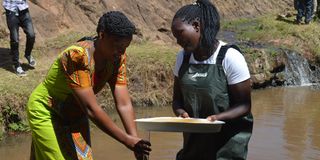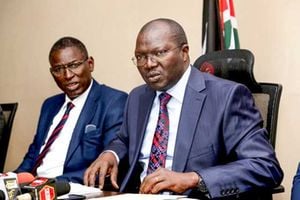How community is fighting pollution in Lake Naivasha basin

Members of Kiriundu Gilgil Water Resource Users Association analysing water samples at Kiriundu stream.
As one drives along Milangine-Gilgil road, one can see a group of women and men busy working on a dry Kiriundu river bed.
The members of Kiriundu Gilgil Water Resource Users Association (WRUA) are out to ensure the residents use water responsibly. They take water samples which they pour in a white tray to identify the macroinvertebrates in the water. They then remove the dirt and compare the invertebrates collected with the ones on a chart.
"We follow every invertebrate, take their scores and record them in a mini stream scoring card. We do more than seven random collections at different points in the stream to know the water’s pollution levels," said Mr John Thuita Wang'ombe, a member of Upper Gilgil Rua, Kiriundu stream.
"We do this exercise monthly and provide information on the ecological condition of the rivers and streams, river health assessment helps us to know the macroinvertebrates in the water," he added.
These are some of the data collected by members of the River Users Association (RUA) who are in the upper, middle, and lower catchment of River Malewa that drains its water into Lake Naivasha.
Last year, WWF-K engaged nine RUAs and gave them water monitoring equipment worth Sh1.9 million. These pieces of equipment were to measure water temperature, quality and to detect living organisms in the water.

Members of Kiriundu Gilgil Water Resource Users Association analysing water at Kiriundu stream.
Mr Thuita is worried that if no action is taken, the river might dry up.
"This stream is slowly drying up and if nothing is done, farmers downstream and ultimately Lake Naivasha will be the main losers," he said.
According to the members of the WRUAs, the main pollutants are discharges from flower farms, hospitals, schools and light industries. There are also oil spills from vehicles which are cleaned at the river banks.
"The car washing industry contributes significantly to water pollution and with the increased number of motorbikes, things can only get worse," said Ms Wanjiru Ng'ethe.
She said that water scarcity and deteriorating water quality due to rapid socio-economic development upstream has forced her to be actively involved in the assessment.
"The assessment results have revealed that the quality of the water they drink is poor. It has also shown that the water volumes in rivers and streams have reduced," said Ms Ng'ethe.
Many farmers in the region don't know about river health and the campaign to create awareness is gathering momentum in a bid to reduce pollution on the rivers and streams.
“We have launched a campaign to create awareness for other farmers and water users. We do it at least once a month. We want to prevent the river ecosystem from further deterioration. We want proper land use which is related to river health," she said.

A member of Kiriundu Gilgil Water Resource Users Association scooping water from Kiriundu stream in Milangine Ward.
She revealed that the macroinvertebrates were sampled from sites along a dry-land river in Milangine to assess biotic responses to land-use changes along the course of the river.
The farmers are upbeat that the results of the assessment will enable water authorities to monitor and safely allocate water to other users.
"We need to protect the water sources. People need to be aware that water they drink comes from clean rivers," said Ms Mary Waihiga.
The residents admit that before they were introduced to river health tips by WWF-K, they had no idea how deeply polluted their rivers and streams were.
"We didn't know about river health assessment but when we received tips from WWF-K, we embarked on a serious monitoring exercise to ensure our rivers are clean. Some youth have embraced the idea and are joining us in this noble exercise," said James Wainaina.
"I joined the group because I use a lot of water from this stream. I am a smallholder farmer and I keep poultry which requires a lot of water," said Ms Lucy Karanja
Mr David Chege, who is in charge of the Upper Gilgil Water Resource User Association, said the Kiriundu stream starts from Gwa Kiongo in Dundori, and its water volume has been reducing every year.
Mr Enock Kiminta, the chairman of Lake Naivasha Basin, a water resource users association that brings together 12 RUAs operating in this basin said: “The activities are geared towards sustainable water management of our resources in Lake Naivasha Basin. The nine WRUAs were supported to conduct a river health assessment and raise awareness through data we collect from the activity. This helps us to identify interventions we can use and deploy to control river pollution.”
He added: "Through citizen science monitoring, we can identify some pollutants that are finding their way into the rivers and identify people or companies polluting the rivers with evidence-based data."

A dry Kiriundu stream in Milangine Ward in Nyandarua County.
He observed that the residents can identify specific pollutants that are finding their way into the rivers including cattle dung, waste from the kitchen and pollutants from milk factories.
"We share this information and data with government agencies like the Water Resources Authority so that we can identify intervention measures to make sure our rivers are not polluted," added Mr Kiminta.
Kenya Rift Lakes Programme manager at WWF-K Dr William Ojwang says Lake Naivasha has been facing degradation because of pollution.
"These community-based interventions will lead to effective proper use of water and address the issue of declining water levels. Some flower farms in Lake Naivasha basin have closed while untreated water discharged in the lake has killed marine life," said Dr Ojwang'.
The river health assessment programme is being supported by WWF-K and it is working through the Water Resources Users Association.
Mr Kiminta said since the residents began the river assessment exercise, they have recorded major success including riparian conservation and planting of trees and reduction of water-borne diseases.





